How Much Does It Cost to Install Ceramic Tile Countertop?
The kitchen countertop gets a lot of use every day and plays a significant role in how your kitchen looks and its overall style. You have many choices for your counter material, and while many people choose slab counters or countertops made of a solid piece of material, it is possible to create a decorative and beautiful countertop using ceramic tile.
Ceramic tile counters are done in patterns, multiple colors, and tiles of all shapes, sizes, and styles. This means getting a completely unique countertop or a countertop that matches some country and farmhouse kitchen styles.
Because many different tile types and edges are used on a countertop, there is a wide range of associated costs. The average cost range for a ceramic tile countertop is $1,050 to $2,000, with most people paying around $1,500 for 30 sq.ft. of handmade tile with bullnose edging. The low cost for this project is around $500 for 30 sq.ft. of builder-grade white tile with a simple bullnose edging, while the high cost is $3,000 for 30 sq.ft. of handmade and hand-painted tile with decorative edging.
Ceramic Countertops Prices
| Ceramic Tile Installation Costs | |
|---|---|
| National average cost | $1,500 |
| Average range | $1,050-$2,000 |
| Low-end | $500 |
| High-end | $3,000 |
In this guide
Ceramic Tile Kitchen Countertops Cost by Tile Type
Ceramic Tile Countertops Cost by Grade
Countertop Edge Costs
Labor Costs to Install a Ceramic Tile Countertop
Pros and Cons of Ceramic Countertops
Ceramic vs Porcelain Countertops
Glaze Considerations for Ceramic Countertops
Ceramic Tile Countertop Maintenance
Ceramic vs Quartz Countertop
Enhancement and Improvement Costs
Additional Considerations
FAQs
Ceramic Tile Countertop Cost by Project Range
Ceramic Tile Countertop Cost by Location
Ceramic tile countertops make a beautiful addition to any area you install them in. The two most common places to use them, however, are in the bathroom and the kitchen. Both areas will have different costs based on the average size of the countertops used in each space. You may also have different costs depending on the type and style of tile, as well as the type of edging.

| Location | Average Costs (Installed) |
|---|---|
| Bathroom | $110 - $600 |
| Kitchen | $540 - $2,000 |
Ceramic Tile Bathroom Countertops
The average cost range to install a ceramic tile countertop in a bathroom is between $110 and $600. Most bathroom countertops are between 6 and 12 square feet on average. It is possible to have larger or smaller countertops, though. In this case, your costs could be different. Ceramic tile works very well in bathrooms and other wet areas. Most ceramic tile resists water well, and in the bathroom, you can coordinate the same tile on the walls or in the shower to create a cohesive look.
Ceramic Tile Kitchen Countertops
The cost to install ceramic tile in the kitchen is between $540 and $2,000, depending on the type of tile. Most kitchens have about 30 sq.ft. of countertop, although a few may have up to 40 sq.ft. It is possible to have a small galley kitchen or a large kitchen with peninsulas 1 and islands 2. In these cases, you may need more or less material, and your costs could be different. Ceramic tile of all kinds works well in the kitchen. Depending on the tile and the edging that you choose, you can have a wide range of styles as well as costs. You can also extend the tile up the backsplash to get a more unified look for the space.
Ceramic Tile Kitchen Countertops Cost by Tile Type
Countertops are a unique area to tile. While most tile is classified as either floor or wall tile, countertops use both types, as long as they meet several conditions. The tiles themselves have a range of costs, depending on their size, how they are made, and the tile type. The following tiles are used for countertops with a few stipulations, which are outlined below:

| Type of Tile | Average Cost per Sq.Ft. |
|---|---|
| Machine-Made Wall Tile | $1 - $10 |
| Floor Tile | $5 - $30 |
| Glazed Terracotta | $10 - $30 |
| Glazed Quarry Pavers | $10 - $50 |
| Handmade Wall Tile | $20 - $50 |
Machine-Made Wall Tile
Machine-made wall tile is a thin tile designed for use on walls and is completely extruded and formed by machine. This means that the tiles are uniform in size and shape and have a very even color.
Machine-made wall tiles are ideal for use on countertops as long as they do not have a crackle or crazed finish. Some ceramic tiles are designed with this finish, but any ceramic tile may craze at any time. However, some are more likely to craze than others. Ceramic wall tiles with matte glazes tend to craze less than those with glossy finishes, but most wall tiles are ideal for countertop use. Machine-made tiles have thinner grout 3 lines, which may be desired because it makes maintenance easier. Machine-made wall tiles range in price from $1 to $10 per square foot.
Floor Tile
Floor tile is any ceramic tile graded a 4 or 5 on the Mohs hardness scale. They are larger and thicker than wall tile, with a textured or matte finish. Floor tile holds up well to countertop use, but many ceramic floor tiles do not have matching bullnose, V-tile, or other edging options. If you choose a floor tile, you may need to edge your countertop in another material, either a different tile or something else like wood or MDF. This means your countertop will not have a uniform appearance. If you choose floor tile, consider looking for those that have a matching bullnose edge. Expect costs to be between $5 and $30 per square foot.
Glazed Terracotta
Glazed terracotta is a thick tile made of red clay, usually fired once. It has a rough, rustic appearance that makes a beautiful complement to southwestern-style kitchens. These tiles tend to be slightly uneven, so you have a wider grout joint, and some tiles may have lippage, which is a corner that sticks up higher than the surrounding tiles. Most glazed terracotta tiles are found with bullnose pieces for the edge, but some do not, so you must find out what your edging options are if you choose this tile. They cost around $10 and $30 per square foot.
Glazed Quarry Pavers
If you want a very long-lasting, highly durable tile for your countertop consider glazed quarry pavers. These thick clay tiles were fired in unique beehive-style kilns. They have a matte glaze that is unlikely to craze and a range of edge pieces available, so choose the edge that makes the most sense. They need a wider grout joint than most machine-made wall tiles, so a stain-resistant grout is recommended. Glazed quarry pavers range from $10 to $50 per square foot.
Handmade Tile
Handmade tile is either completely made and glazed by hand or extruded by machine before being cut and glazed by hand. This tile is often thicker, has many more options for size, shape, and glaze, and has a lot of color variation from one tile to the next, providing a more varied and rich-looking countertop. There is a wide range of edge pieces available as well. Handmade tiles require a wider grout joint, and most producers grade or rate their tiles for countertop use. Any floor tile is fine for countertop use. Tiles graded 3 or higher on the Mohs hardness scale are ideal for countertop use, and tiles graded 1 or 2 are used in very light-use situations. Handmade tiles are expensive, ranging from $20 and $50 per square foot.
Ceramic Tile Countertops Cost by Grade
Tiles are graded 4 on the Mohs hardness scale of 1 to 5, one being the most fragile tile and 5 being rated for commercial floor use. Floor tiles are always graded 4 and above, and wall tiles are considered for light floor use, such as a bathroom at 3 or above.
Technically, any tile may be used on countertops, but if you plan on doing a lot of cutting, cooking, baking, and other heavy use, look for tiles rated 3 or above. All tiles of all grades have a wide range of associated costs. It is possible to find some very expensive grade 1 tiles and some very inexpensive grade 5 tiles.
Grade 5 tiles are thicker with a more durable glaze than a grade 1 tile. Unless you are considering a handmade tile, the higher the grade, the more the tile costs. Below is a range of costs for machine-made tile by grade.

| Tile Grade | Suggested Use | Cost Range per Sq.Ft. |
|---|---|---|
| 1 | Wall Light Countertop | $1 - $10 |
| 2 | Wall Light Countertop | $3 - $10 |
| 3 | Wall Countertop Light Floor | $5 - $15 |
| 4 | Wall Countertop Residential Floor | $5 - $20 |
| 5 | Wall Countertop Commercial and Residential Floor | $5 - $30 |
Countertop Edge Costs
When you tile a countertop, the tiles themselves are only ¼ to ⅜-inch thick, while the countertop itself may be 2 or more inches thick. You need to have a way to finish the edge and turn a corner at the front of the countertop. This is accomplished in a few different ways, depending on your style preference. Each option has a different cost and appearance to consider:

| Edge | Cost per Piece |
|---|---|
| Bullnose | $0.50 - $15 |
| Quarter Round | $1 - $5 |
| Pencil | $1 - $10 |
| V-Tile | $2 - $20 |
| Molding | $2 - $30 |
Bullnose
This is the simplest way to create an edge. It is a ceramic tile that matches your other tiles, but with a rounded edge. Place this tile so that its rounded edge turns the corner either facing down and lies on the top of the counter or facing up to form the vertical edge. These cost between $0.50 and $15 per piece on average.
Quarter Round
A quarter round is a curved piece of tile that sits on the counter’s exposed edge. You need a full tile on either side of it to complete the edge. Quarter rounds are plain or decorative, and they are used in a contrasting color to the rest of your trim for a more decorative look. They cost between $1 and $5 a piece.
Pencil
A pencil tile is thicker and more prominent than a quarter round but installs in the same way. This tile sticks out slightly more on the edge, bumping out a bit. Because of the way it is positioned, use a pencil edge if you want to change the color or draw attention to it. They range in cost from $1 to $10 a piece.
V-tile
Most tile countertops have a V-tile edge. This is a tile shaped like a V, with two glazed sides forming a 90-degree angle. It fits right over the edge of the countertop, making a nicely defined and finished edge in one piece. They cost between $2 and $20 a piece.
Molding
If you want a more decorative look, choose a molding, such as a chair rail 5 or ogee, to create a tile edge. This attaches to the front of the countertop and extends upward so that the field tile on top dives straight into it. Expect to pay between $2 and $30 a piece.
Labor Costs to Install a Ceramic Tile Countertop
The cost to install a ceramic tile countertop is around $15 a square foot, or $450 for a 30 sq.ft. countertop. You may tile an existing laminate countertop, but more commonly, the countertop is built using cement backer board. The backer board is cut to fit, and the sink hole is cut. It is then screwed down to the countertop and covered in mortar 6. The mortar is keyed to the correct depth for the tile size, and the tiles are laid and beaten in. The edge tiles are placed along the front and may be taped in place briefly while the mortar cures. After 24 hours, the tile is grouted and cleaned, and the sink is dropped in and installed. The backsplash is usually tiled at the same time.

Pros and Cons of Ceramic Countertops
Ceramic countertops are beautiful, decorative, and durable. Ceramic tiles are fired to high temperatures, so they withstand the heat from a pan placed directly on top of them without issue. Many tiles are durable enough to cut on directly, although some require a cutting board. A ceramic tile countertop creates a wide range of looks for your kitchen, often at a much lower cost than a solid slab countertop.
The biggest drawback to a ceramic countertop is the many grout lines. Grout is porous and should either be sealed to prevent staining, or a pre-sealed grout or an epoxy grout should be used. Both pre-sealed grouts and epoxy grouts are very difficult to work with, so they increase the cost of your project, although they impede staining and help your counter stay looking great for longer.
Ceramic vs Porcelain Countertops
Another great option for a tile counter is porcelain tile. Porcelain is a clay tile, but it is made of clay dust that has been tightly compacted, and then fired to extremely high temperatures. This makes the tile much denser and more durable. Porcelain is often unglazed, so the color goes right through.
Porcelain tiles resist staining and cracking, and because there is no glaze, they never craze or require sealing. However, many porcelain tiles do not have bullnose tiles or edge options for finishing a countertop. Your installer needs to create bullnose on-site, which is not an option with some tiles.
In addition, porcelain tiles do not have the same range of color or size as ceramic tiles, so your options are more limited. Porcelain and ceramic countertops cost roughly the same. However, if your installer creates bullnose edging, your installation costs could be much higher.
Glaze Considerations for Ceramic Countertops
Ceramic tiles are always glazed, making the tile water-resistant and impervious to staining. However, not all glazes are created equally, and not all glazes are ideal for countertop use.
Crazed or crackle finishes should be avoided because they stain and are difficult to clean. If your tile crazes over time, seal the crazed tile to prevent staining.
Green glazes are usually made with copper, which reacts badly when it comes in contact with acids, such as lemon juice or tomatoes. Most glossy green glazes, particularly dark green, are not rated for countertop use. Light, pale green and matte glazes may be rated for countertop use but check with the manufacturer.
Most metallic glazes are also not rated for countertop use because they frequently contain copper, aluminum, and other metals that react badly with acids.
Ceramic Tile Countertop Maintenance
Ceramic tile countertops are fairly low maintenance. Wash them with your preferred cleaner as needed, and unless they are crazed, the tiles do not require sealing.
However, the biggest maintenance need of these countertops is the grout. Grout is made of cement and is porous and stains. You must either seal the grout yearly to prevent staining or use a pre-sealed or epoxy grout to prevent staining and keep your countertop easy to clean and care for.
Ceramic vs Quartz Countertop
If you’re looking for a versatile, man-made material for your kitchen countertop, both ceramic and quartz make good options. These are two very different materials, however, in composition, looks, and installation. Ceramic tile is made of clay that has been glazed and fired. It’s installed in individual pieces on your countertop, so you can have a range of patterns, colors, and sizes to choose from.
Quartz is a slab countertop made of roughly 93% natural quartz stone mixed with pigments and resins. It’s cut and shaped to fit your cabinets in one, continuous piece. Quartz can resemble other materials such as granite, marble, and concrete. Of the two, quartz can be more expensive in general, ranging from $1,750 to $3,000 on average.
Enhancement and Improvement Costs
Painting Ceramic Countertops
Ceramic tile is paintable if you want to change the color of the tile. Use a urethane-based paint and a primer 7. Edge each tile first, then paint the center. If you wish to change the color of the grout, you must use a grout paint for this. Do not use regular paint on the grout. Professional painters charge roughly $50 an hour for their work, so the smaller the tiles, the longer this job takes and the higher the cost.
Disposal of Old Countertop
If you are replacing an existing countertop, you may have removal and disposal fees as well. The old countertop will need to have removed, and some installers will do this at no additional cost. Others will charge between $50 and $200, depending on what the material is and how large the countertop is.
Backsplash Installation
Tiling a countertop is a great time to tile the backsplash 8 as well. You can use the same material on your backsplash as your countertop to get a cohesive look, or use something different for a contrast. Doing both at the same time may also get you a discounted price from your installed. On average, a ceramic tile backsplash costs around $900 to install.
Drywall Repair
Sometimes during the removal of old countertops or backsplashes, the drywall 9 may be damaged and need repair. The cost to repair drywall is around $180 on average.
Cooktop
If you have a cooktop, you need to have it on hand or have the template nearby prior to tiling the counter so that a hole is cut and left for it. This may add a cost of $100 to the project, plus the cost of the cooktop and installation, which ranges from $500 to $1,000.
Sink Installation
You have two options for sink installation with a tile countertop - drop-in and tile-in. Drop-in sinks are hung from the countertop by their edge and do not change the installation cost. Tile-in sinks are flush with the counter and add another $50 - $100 to the project cost.
Additional Considerations and Costs
- Old laminate countertop. If you have a laminate countertop, you may tile directly on top of it, which saves the cost of removing the old countertop and installing the new backer board.
- Extra material. You need a minimum of 10% extra material plus one or two additional edge pieces in case of waste, breakage, or future repairs. If you use a highly variegated tile or are creating a complex pattern, increase this to 20%.
- Discouts. Your installer may offer discounts if you have other areas tiled at the same time, such as the backsplash or kitchen floor.
- Heat resistance. Ceramic and porcelain tile countertops resist heat well because they were fired to such high temperatures, so a hot pad 10 is generally not needed.
FAQs
- Is ceramic tile good for kitchen countertops?
Yes, ceramic tile makes an excellent material for a kitchen countertop. Just keep the grout sealed to avoid staining.
- Do ceramic countertops increase the resale value of a house?
Ceramic countertops do not increase the resale value of a house. However, a new countertop is associated with recently remodeled spaces, which increases the value of a home.
Remodeling Terms Cheat Sheet
Definitions in laymen's terms, cost considerations, pictures and things you need to know.See full cheat sheet.
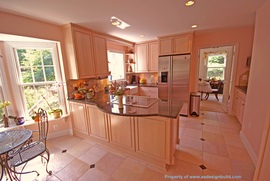 1 Peninsulas: A metaphorical term for an extended kitchen counter space connected to the wall on only one side
1 Peninsulas: A metaphorical term for an extended kitchen counter space connected to the wall on only one side
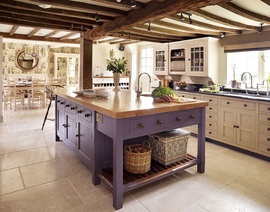 2 Islands: A kitchen counter that is not attached to walls or other surfaces, and that can be accessed from all sides
2 Islands: A kitchen counter that is not attached to walls or other surfaces, and that can be accessed from all sides
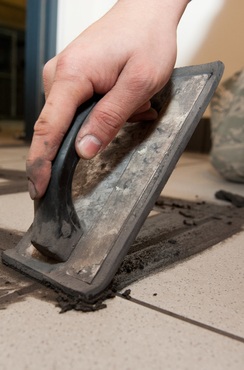 3 Grout: A fluid form of cement used to seal the joints between tiles. It also makes the surface stronger because it bonds the tiles together
3 Grout: A fluid form of cement used to seal the joints between tiles. It also makes the surface stronger because it bonds the tiles together
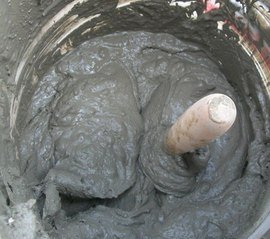 6 Mortar: A mixture of Portland cement or lime or a combination of both, sand, and water used to bind bricks, stones, and concrete masonry units together
6 Mortar: A mixture of Portland cement or lime or a combination of both, sand, and water used to bind bricks, stones, and concrete masonry units together
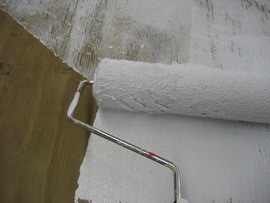 7 Primer: Preparatory coat applied to materials (drywall, wood, metal, etc.) before painting to ensure paint adhesion, extend paint durability, and help seal and protect the surface to be painted
7 Primer: Preparatory coat applied to materials (drywall, wood, metal, etc.) before painting to ensure paint adhesion, extend paint durability, and help seal and protect the surface to be painted
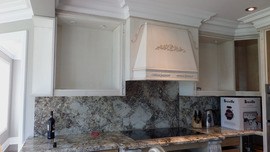 8 Backsplash: The upright surface, often made of tile, behind a kitchen counter, sink, or stove, that protects the wall from damage from splatter due to kitchen activities
8 Backsplash: The upright surface, often made of tile, behind a kitchen counter, sink, or stove, that protects the wall from damage from splatter due to kitchen activities
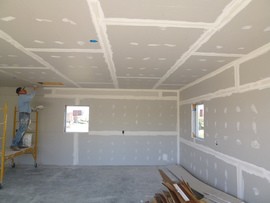 9 Drywall: Type of plasterboard, commonly used to build walls and ceilings, composed of gypsum that is layered between sheets of heavy paper
9 Drywall: Type of plasterboard, commonly used to build walls and ceilings, composed of gypsum that is layered between sheets of heavy paper
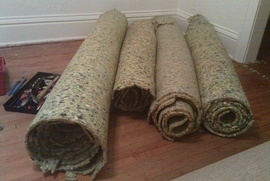 10 Pad: A cushion placed under a carpet to absorb impact, thus extending the life of the carpet
10 Pad: A cushion placed under a carpet to absorb impact, thus extending the life of the carpet
How much does it cost to install ceramic tile countertop in my city?
Cost to install ceramic tile countertop varies greatly by region (and even by zip code). To get free estimates from local contractors, please indicate yours.





